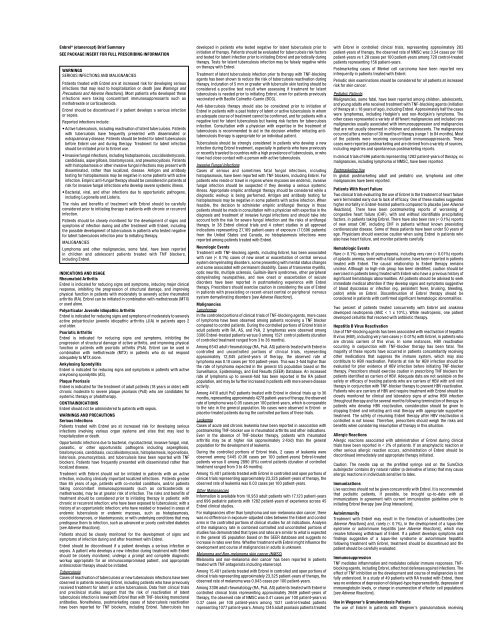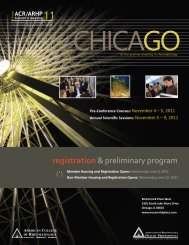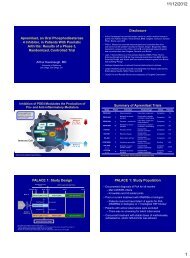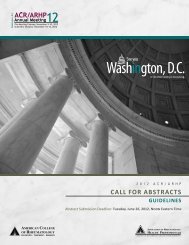Program Book - Confex
Program Book - Confex
Program Book - Confex
- No tags were found...
Create successful ePaper yourself
Turn your PDF publications into a flip-book with our unique Google optimized e-Paper software.
Enbrel ® (etanercept) Brief Summary<br />
SEE PACKAGE INSERT FOR FULL PRESCRIBING INFORMATION<br />
WARNINGS<br />
SERIOUS INFECTIONS AND MALIGNANCIES<br />
Patients treated with Enbrel are at increased risk for developing serious<br />
infections that may lead to hospitalization or death [see Warnings and<br />
Precautions and Adverse Reactions]. Most patients who developed these<br />
infections were taking concomitant immunosuppressants such as<br />
methotrexate or corticosteroids.<br />
Enbrel should be discontinued if a patient develops a serious infection<br />
or sepsis.<br />
Reported infections include:<br />
• Active tuberculosis, including reactivation of latent tuberculosis. Patients<br />
with tuberculosis have frequently presented with disseminated or<br />
extrapulmonary disease. Patients should be tested for latent tuberculosis<br />
before Enbrel use and during therapy. Treatment for latent infection<br />
should be initiated prior to Enbrel use.<br />
• Invasive fungal infections, including histoplasmosis, coccidioidomycosis,<br />
candidiasis, aspergillosis, blastomycosis, and pneumocystosis. Patients<br />
with histoplasmosis or other invasive fungal infections may present with<br />
disseminated, rather than localized, disease. Antigen and antibody<br />
testing for histoplasmosis may be negative in some patients with active<br />
infection. Empiric anti-fungal therapy should be considered in patients at<br />
risk for invasive fungal infections who develop severe systemic illness.<br />
• Bacterial, viral, and other infections due to opportunistic pathogens,<br />
including Legionella and Listeria.<br />
The risks and benefits of treatment with Enbrel should be carefully<br />
considered prior to initiating therapy in patients with chronic or recurrent<br />
infection.<br />
Patients should be closely monitored for the development of signs and<br />
symptoms of infection during and after treatment with Enbrel, including<br />
the possible development of tuberculosis in patients who tested negative<br />
for latent tuberculosis infection prior to initiating therapy.<br />
MALIGNANCIES<br />
Lymphoma and other malignancies, some fatal, have been reported<br />
in children and adolescent patients treated with TNF blockers,<br />
including Enbrel.<br />
INDICATIONS AND USAGE<br />
Rheumatoid Arthritis<br />
Enbrel is indicated for reducing signs and symptoms, inducing major clinical<br />
response, inhibiting the progression of structural damage, and improving<br />
physical function in patients with moderately to severely active rheumatoid<br />
arthritis (RA). Enbrel can be initiated in combination with methotrexate (MTX)<br />
or used alone.<br />
Polyarticular Juvenile Idiopathic Arthritis<br />
Enbrel is indicated for reducing signs and symptoms of moderately to severely<br />
active polyarticular juvenile idiopathic arthritis (JIA) in patients ages 2<br />
and older.<br />
Psoriatic Arthritis<br />
Enbrel is indicated for reducing signs and symptoms, inhibiting the<br />
progression of structural damage of active arthritis, and improving physical<br />
function in patients with psoriatic arthritis (PsA). Enbrel can be used in<br />
combination with methotrexate (MTX) in patients who do not respond<br />
adequately to MTX alone.<br />
Ankylosing Spondylitis<br />
Enbrel is indicated for reducing signs and symptoms in patients with active<br />
ankylosing spondylitis (AS).<br />
Plaque Psoriasis<br />
Enbrel is indicated for the treatment of adult patients (18 years or older) with<br />
chronic moderate to severe plaque psoriasis (PsO) who are candidates for<br />
systemic therapy or phototherapy.<br />
CONTRAINDICATIONS<br />
Enbrel should not be administered to patients with sepsis.<br />
WARNINGS AND PRECAUTIONS<br />
Serious Infections<br />
Patients treated with Enbrel are at increased risk for developing serious<br />
infections involving various organ systems and sites that may lead to<br />
hospitalization or death.<br />
Opportunistic infections due to bacterial, mycobacterial, invasive fungal, viral,<br />
parasitic, or other opportunistic pathogens including aspergillosis,<br />
blastomycosis, candidiasis, coccidioidomycosis, histoplasmosis, legionellosis,<br />
listeriosis, pneumocystosis, and tuberculosis have been reported with TNF<br />
blockers. Patients have frequently presented with disseminated rather than<br />
localized disease.<br />
Treatment with Enbrel should not be initiated in patients with an active<br />
infection, including clinically important localized infections. Patients greater<br />
than 65 years of age, patients with co-morbid conditions, and/or patients<br />
taking concomitant immunosuppressants (such as corticosteroids or<br />
methotrexate), may be at greater risk of infection. The risks and benefits of<br />
treatment should be considered prior to initiating therapy in patients: with<br />
chronic or recurrent infection; who have been exposed to tuberculosis; with a<br />
history of an opportunistic infection; who have resided or traveled in areas of<br />
endemic tuberculosis or endemic mycoses, such as histoplasmosis,<br />
coccidioidomycosis, or blastomycosis; or with underlying conditions that may<br />
predispose them to infection, such as advanced or poorly controlled diabetes<br />
[see Adverse Reactions].<br />
Patients should be closely monitored for the development of signs and<br />
symptoms of infection during and after treatment with Enbrel.<br />
Enbrel should be discontinued if a patient develops a serious infection or<br />
sepsis. A patient who develops a new infection during treatment with Enbrel<br />
should be closely monitored, undergo a prompt and complete diagnostic<br />
workup appropriate for an immunocompromised patient, and appropriate<br />
antimicrobial therapy should be initiated.<br />
Tuberculosis<br />
Cases of reactivation of tuberculosis or new tuberculosis infections have been<br />
observed in patients receiving Enbrel, including patients who have previously<br />
received treatment for latent or active tuberculosis. Data from clinical trials<br />
and preclinical studies suggest that the risk of reactivation of latent<br />
tuberculosis infection is lower with Enbrel than with TNF-blocking monoclonal<br />
antibodies. Nonetheless, postmarketing cases of tuberculosis reactivation<br />
have been reported for TNF blockers, including Enbrel. Tuberculosis has<br />
developed in patients who tested negative for latent tuberculosis prior to<br />
initiation of therapy. Patients should be evaluated for tuberculosis risk factors<br />
and tested for latent infection prior to initiating Enbrel and periodically during<br />
therapy. Tests for latent tuberculosis infection may be falsely negative while<br />
on therapy with Enbrel.<br />
Treatment of latent tuberculosis infection prior to therapy with TNF-blocking<br />
agents has been shown to reduce the risk of tuberculosis reactivation during<br />
therapy. Induration of 5 mm or greater with tuberculin skin testing should be<br />
considered a positive test result when assessing if treatment for latent<br />
tuberculosis is needed prior to initiating Enbrel, even for patients previously<br />
vaccinated with Bacille Calmette-Guerin (BCG).<br />
Anti-tuberculosis therapy should also be considered prior to initiation of<br />
Enbrel in patients with a past history of latent or active tuberculosis in whom<br />
an adequate course of treatment cannot be confirmed, and for patients with a<br />
negative test for latent tuberculosis but having risk factors for tuberculosis<br />
infection. Consultation with a physician with expertise in the treatment of<br />
tuberculosis is recommended to aid in the decision whether initiating antituberculosis<br />
therapy is appropriate for an individual patient.<br />
Tuberculosis should be strongly considered in patients who develop a new<br />
infection during Enbrel treatment, especially in patients who have previously<br />
or recently traveled to countries with a high prevalence of tuberculosis, or who<br />
have had close contact with a person with active tuberculosis.<br />
Invasive Fungal Infections<br />
Cases of serious and sometimes fatal fungal infections, including<br />
histoplasmosis, have been reported with TNF blockers, including Enbrel. For<br />
patients who reside or travel in regions where mycoses are endemic, invasive<br />
fungal infection should be suspected if they develop a serious systemic<br />
illness. Appropriate empiric antifungal therapy should be considered while a<br />
diagnostic workup is being performed. Antigen and antibody testing for<br />
histoplasmosis may be negative in some patients with active infection. When<br />
feasible, the decision to administer empiric antifungal therapy in these<br />
patients should be made in consultation with a physician with expertise in the<br />
diagnosis and treatment of invasive fungal infections and should take into<br />
account both the risk for severe fungal infection and the risks of antifungal<br />
therapy. In 38 Enbrel clinical trials and 4 cohort studies in all approved<br />
indications representing 27,169 patient-years of exposure (17,696 patients)<br />
from the United States and Canada, no histoplasmosis infections were<br />
reported among patients treated with Enbrel.<br />
Neurologic Events<br />
Treatment with TNF-blocking agents, including Enbrel, has been associated<br />
with rare (< 0.1%) cases of new onset or exacerbation of central nervous<br />
system demyelinating disorders, some presenting with mental status changes<br />
and some associated with permanent disability. Cases of transverse myelitis,<br />
optic neuritis, multiple sclerosis, Guillain-Barré syndromes, other peripheral<br />
demyelinating neuropathies, and new onset or exacerbation of seizure<br />
disorders have been reported in postmarketing experience with Enbrel<br />
therapy. Prescribers should exercise caution in considering the use of Enbrel<br />
in patients with preexisting or recent-onset central or peripheral nervous<br />
system demyelinating disorders [see Adverse Reactions].<br />
Malignancies<br />
Lymphomas<br />
In the controlled portions of clinical trials of TNF-blocking agents, more cases<br />
of lymphoma have been observed among patients receiving a TNF blocker<br />
compared to control patients. During the controlled portions of Enbrel trials in<br />
adult patients with RA, AS, and PsA, 2 lymphomas were observed among<br />
3306 Enbrel-treated patients versus 0 among 1521 control patients (duration<br />
of controlled treatment ranged from 3 to 36 months).<br />
Among 6543 adult rheumatology (RA, PsA, AS) patients treated with Enbrel in<br />
controlled and uncontrolled portions of clinical trials, representing<br />
approximately 12,845 patient-years of therapy, the observed rate of<br />
lymphoma was 0.10 cases per 100 patient-years. This was 3-fold higher than<br />
the rate of lymphoma expected in the general US population based on the<br />
Surveillance, Epidemiology, and End Results (SEER) Database. An increased<br />
rate of lymphoma up to several-fold has been reported in the RA patient<br />
population, and may be further increased in patients with more severe disease<br />
activity.<br />
Among 4410 adult PsO patients treated with Enbrel in clinical trials up to 36<br />
months, representing approximately 4278 patient-years of therapy, the observed<br />
rate of lymphoma was 0.05 cases per 100 patient-years, which is comparable<br />
to the rate in the general population. No cases were observed in Enbrel- or<br />
placebo-treated patients during the controlled portions of these trials.<br />
Leukemia<br />
Cases of acute and chronic leukemia have been reported in association with<br />
postmarketing TNF-blocker use in rheumatoid arthritis and other indications.<br />
Even in the absence of TNF-blocker therapy, patients with rheumatoid<br />
arthritis may be at higher risk (approximately 2-fold) than the general<br />
population for the development of leukemia.<br />
During the controlled portions of Enbrel trials, 2 cases of leukemia were<br />
observed among 5445 (0.06 cases per 100 patient-years) Enbrel-treated<br />
patients versus 0 among 2890 (0%) control patients (duration of controlled<br />
treatment ranged from 3 to 48 months).<br />
Among 15,401 patients treated with Enbrel in controlled and open portions of<br />
clinical trials representing approximately 23,325 patient-years of therapy, the<br />
observed rate of leukemia was 0.03 cases per 100 patient-years.<br />
Other Malignancies<br />
Information is available from 10,953 adult patients with 17,123 patient-years<br />
and 696 pediatric patients with 1282 patient-years of experience across 45<br />
Enbrel clinical studies.<br />
For malignancies other than lymphoma and non-melanoma skin cancer, there<br />
was no difference in exposure-adjusted rates between the Enbrel and control<br />
arms in the controlled portions of clinical studies for all indications. Analysis<br />
of the malignancy rate in combined controlled and uncontrolled portions of<br />
studies has demonstrated that types and rates are similar to what is expected<br />
in the general US population based on the SEER database and suggests no<br />
increase in rates over time. Whether treatment with Enbrel might influence the<br />
development and course of malignancies in adults is unknown.<br />
Melanoma and Non-melanoma skin cancer (NMSC)<br />
Melanoma and non-melanoma skin cancer has been reported in patients<br />
treated with TNF antagonists including etanercept.<br />
Among 15,401 patients treated with Enbrel in controlled and open portions of<br />
clinical trials representing approximately 23,325 patient-years of therapy, the<br />
observed rate of melanoma was 0.043 cases per 100 patient-years.<br />
Among 3306 adult rheumatology (RA, PsA, AS) patients treated with Enbrel in<br />
controlled clinical trials representing approximately 2669 patient-years of<br />
therapy, the observed rate of NMSC was 0.41 cases per 100 patient-years vs<br />
0.37 cases per 100 patient-years among 1521 control-treated patients<br />
representing 1077 patient-years. Among 1245 adult psoriasis patients treated<br />
with Enbrel in controlled clinical trials, representing approximately 283<br />
patient-years of therapy, the observed rate of NMSC was 3.54 cases per 100<br />
patient-years vs 1.28 cases per 100 patient-years among 720 control-treated<br />
patients representing 156 patient-years.<br />
Postmarketing cases of Merkel cell carcinoma have been reported very<br />
infrequently in patients treated with Enbrel.<br />
Periodic skin examinations should be considered for all patients at increased<br />
risk for skin cancer.<br />
Pediatric Patients<br />
Malignancies, some fatal, have been reported among children, adolescents,<br />
and young adults who received treatment with TNF-blocking agents (initiation<br />
of therapy at ≤ 18 years of age), including Enbrel. Approximately half the cases<br />
were lymphomas, including Hodgkin’s and non-Hodgkin’s lymphoma. The<br />
other cases represented a variety of different malignancies and included rare<br />
malignancies usually associated with immunosuppression and malignancies<br />
that are not usually observed in children and adolescents. The malignancies<br />
occurred after a median of 30 months of therapy (range 1 to 84 months). Most<br />
of the patients were receiving concomitant immunosuppressants. These<br />
cases were reported postmarketing and are derived from a variety of sources,<br />
including registries and spontaneous postmarketing reports.<br />
In clinical trials of 696 patients representing 1282 patient-years of therapy, no<br />
malignancies, including lymphoma or NMSC, have been reported.<br />
Postmarketing Use<br />
In global postmarketing adult and pediatric use, lymphoma and other<br />
malignancies have been reported.<br />
Patients With Heart Failure<br />
Two clinical trials evaluating the use of Enbrel in the treatment of heart failure<br />
were terminated early due to lack of efficacy. One of these studies suggested<br />
higher mortality in Enbrel-treated patients compared to placebo [see Adverse<br />
Reactions]. There have been postmarketing reports of worsening of<br />
congestive heart failure (CHF), with and without identifiable precipitating<br />
factors, in patients taking Enbrel. There have also been rare (< 0.1%) reports<br />
of new onset CHF, including CHF in patients without known preexisting<br />
cardiovascular disease. Some of these patients have been under 50 years of<br />
age. Physicians should exercise caution when using Enbrel in patients who<br />
also have heart failure, and monitor patients carefully.<br />
Hematologic Events<br />
Rare (< 0.1%) reports of pancytopenia, including very rare (< 0.01%) reports<br />
of aplastic anemia, some with a fatal outcome, have been reported in patients<br />
treated with Enbrel. The causal relationship to Enbrel therapy remains<br />
unclear. Although no high-risk group has been identified, caution should be<br />
exercised in patients being treated with Enbrel who have a previous history of<br />
significant hematologic abnormalities. All patients should be advised to seek<br />
immediate medical attention if they develop signs and symptoms suggestive<br />
of blood dyscrasias or infection (eg, persistent fever, bruising, bleeding,<br />
pallor) while on Enbrel. Discontinuation of Enbrel therapy should be<br />
considered in patients with confirmed significant hematologic abnormalities.<br />
Two percent of patients treated concurrently with Enbrel and anakinra<br />
developed neutropenia (ANC < 1 x 10 9 /L). While neutropenic, one patient<br />
developed cellulitis that resolved with antibiotic therapy.<br />
Hepatitis B Virus Reactivation<br />
Use of TNF-blocking agents has been associated with reactivation of hepatitis<br />
B virus (HBV), including very rare cases (< 0.01%) with Enbrel, in patients who<br />
are chronic carriers of this virus. In some instances, HBV reactivation<br />
occurring in conjunction with TNF-blocker therapy has been fatal. The<br />
majority of these reports have occurred in patients concomitantly receiving<br />
other medications that suppress the immune system, which may also<br />
contribute to HBV reactivation. Patients at risk for HBV infection should be<br />
evaluated for prior evidence of HBV infection before initiating TNF-blocker<br />
therapy. Prescribers should exercise caution in prescribing TNF blockers for<br />
patients identified as carriers of HBV. Adequate data are not available on the<br />
safety or efficacy of treating patients who are carriers of HBV with anti viral<br />
therapy in conjunction with TNF-blocker therapy to prevent HBV reactivation.<br />
Patients who are carriers of HBV and require treatment with Enbrel should be<br />
closely monitored for clinical and laboratory signs of active HBV infection<br />
throughout therapy and for several months following termination of therapy. In<br />
patients who develop HBV reactivation, consideration should be given to<br />
stopping Enbrel and initiating anti viral therapy with appropriate supportive<br />
treatment. The safety of resuming Enbrel therapy after HBV reactivation is<br />
controlled is not known. Therefore, prescribers should weigh the risks and<br />
benefits when considering resumption of therapy in this situation.<br />
Allergic Reactions<br />
Allergic reactions associated with administration of Enbrel during clinical<br />
trials have been reported in < 2% of patients. If an anaphylactic reaction or<br />
other serious allergic reaction occurs, administration of Enbrel should be<br />
discontinued immediately and appropriate therapy initiated.<br />
Caution: The needle cap on the prefilled syringe and on the SureClick<br />
autoinjector contains dry natural rubber (a derivative of latex) that may cause<br />
allergic reactions in individuals sensitive to latex.<br />
Immunizations<br />
Live vaccines should not be given concurrently with Enbrel. It is recommended<br />
that pediatric patients, if possible, be brought up-to-date with all<br />
immunizations in agreement with current immunization guidelines prior to<br />
initiating Enbrel therapy [see Drug Interactions].<br />
Autoimmunity<br />
Treatment with Enbrel may result in the formation of autoantibodies [see<br />
Adverse Reactions] and, rarely (< 0.1%), in the development of a lupus-like<br />
syndrome or autoimmune hepatitis [see Adverse Reactions], which may<br />
resolve following withdrawal of Enbrel. If a patient develops symptoms and<br />
findings suggestive of a lupus-like syndrome or autoimmune hepatitis<br />
following treatment with Enbrel, treatment should be discontinued and the<br />
patient should be carefully evaluated.<br />
Immunosuppression<br />
TNF mediates inflammation and modulates cellular immune responses. TNFblocking<br />
agents, including Enbrel, affect host defenses against infections. The<br />
effect of TNF inhibition on the development and course of malignancies is not<br />
fully understood. In a study of 49 patients with RA treated with Enbrel, there<br />
was no evidence of depression of delayed-type hypersensitivity, depression of<br />
immunoglobulin levels, or change in enumeration of effector cell populations<br />
[see Adverse Reactions].<br />
Use in Wegener’s Granulomatosis Patients<br />
The use of Enbrel in patients with Wegener’s granulomatosis receiving





